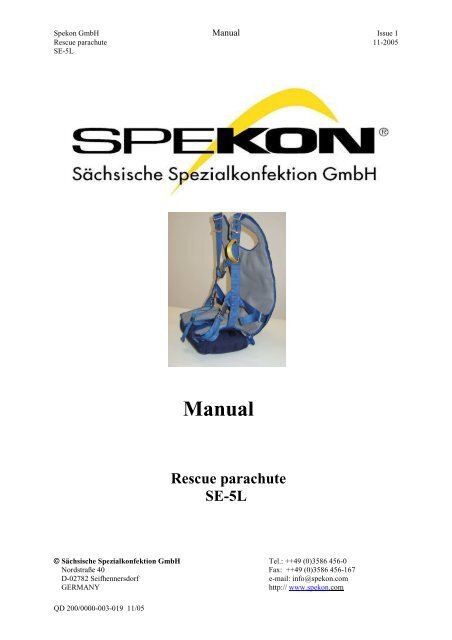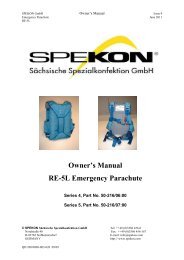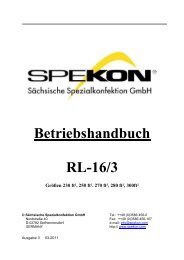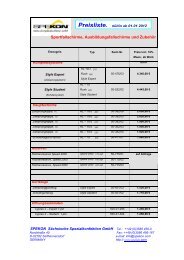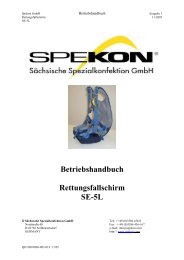SE-5L engl.11_05 - Sächsische Spezialkonfektion GmbH
SE-5L engl.11_05 - Sächsische Spezialkonfektion GmbH
SE-5L engl.11_05 - Sächsische Spezialkonfektion GmbH
Create successful ePaper yourself
Turn your PDF publications into a flip-book with our unique Google optimized e-Paper software.
Spekon <strong>GmbH</strong> Manual Issue 1<br />
Rescue parachute 11-20<strong>05</strong><br />
<strong>SE</strong>-<strong>5L</strong><br />
QD 200/0000-003-019 11/<strong>05</strong><br />
Manual<br />
Rescue parachute<br />
<strong>SE</strong>-<strong>5L</strong><br />
© <strong>Sächsische</strong> <strong>Spezialkonfektion</strong> <strong>GmbH</strong> Tel.: ++49 (0)3586 456-0<br />
Nordstraße 40 Fax: ++49 (0)3586 456-167<br />
D-02782 Seifhennersdorf e-mail: info@spekon.com<br />
GERMANY http:// www.spekon.com
Spekon <strong>GmbH</strong> Manual Issue 1<br />
Rescue parachute 11-20<strong>05</strong><br />
<strong>SE</strong>-<strong>5L</strong><br />
Index<br />
Index........................................................................................................................... 2<br />
Description.................................................................................................................. 3<br />
Technical data......................................................................................................... 3<br />
Variants................................................................................................................... 3<br />
Comments............................................................................................................... 3<br />
Completion.............................................................................................................. 4<br />
Opening and operation ............................................................................................... 4<br />
Description of the canopy ........................................................................................... 4<br />
Parachute................................................................................................................ 4<br />
Pilot Chute .............................................................................................................. 4<br />
Pack Sack / Container............................................................................................. 5<br />
Rig........................................................................................................................... 5<br />
Opening device ....................................................................................................... 5<br />
Maintenance / Inspection............................................................................................ 6<br />
Packing tools .............................................................................................................. 7<br />
Inspection................................................................................................................ 7<br />
Steps prior to packing ............................................................................................. 7<br />
Folding the canopy.................................................................................................. 8<br />
Packing the strap ends............................................................................................ 8<br />
Looping the lines..................................................................................................... 9<br />
Placing the canopy inside the deployment bag....................................................... 9<br />
Packing the bridle and closing the deployment bag ................................................ 9<br />
Storage, maintenance and repair ............................................................................. 10<br />
Storage ................................................................................................................. 10<br />
Maintenance ......................................................................................................... 10<br />
Repair ................................................................................................................... 11<br />
Inspection.............................................................................................................. 11<br />
Parts and components.............................................................................................. 11<br />
Terminology .......................................................................................................... 11<br />
Figure part ................................................................................................................ 12<br />
QD 200/0000-003-019 11/<strong>05</strong> 2 von 16
Spekon <strong>GmbH</strong> Manual Issue 1<br />
Rescue parachute 11-20<strong>05</strong><br />
<strong>SE</strong>-<strong>5L</strong><br />
Description<br />
The parachute <strong>SE</strong>/<strong>5L</strong> is a person carrying parachute. It finds use as rescue parachute for aviation pilots and their<br />
accompanying personnel. The rescue parachute <strong>SE</strong>-<strong>5L</strong> is a plain seat-parachute according to its fit. This canopy<br />
can either be deployed manually by pulling a handle or automatically through the rip cord which is attached to<br />
the plane.<br />
The rescue parachute <strong>SE</strong>-<strong>5L</strong> complies with the requirements of ETSO-C 23d (Ed. of 04-28-1998)<br />
Technical data<br />
Size of surface area of the canopy approx. 41.5 sqm<br />
Number of cells and lines 24<br />
Size of the packed container 300x380x110 mm<br />
Mass of the packed canopy 8.5<br />
Force for opening closing device min. 2.3 daN, max. 9.7 daN<br />
Permitted load capacity 50 – 122 kg<br />
Minimum opening altitude in freefall 125 m<br />
Minimum exit altitude in horizontal flight 110 km/h 80 m<br />
Permitted action speed 327 km/h at max. 115 kg<br />
278 km/h at max. 122 kg<br />
Turning speed approx. 30 degrees/sec<br />
Forward speed 1-2 m/s<br />
Descent rate near surface<br />
- at 77 kg suspended weight 6.1 m/s<br />
- at 122 kg suspended weight 7.2 m/s<br />
Duration of operability 15 years<br />
Pack cycle 180 days<br />
Variants<br />
The P/N 50769/01-(xyz) consists of following details:<br />
50-769/01 – basic part number, changes of this number are major changes<br />
x – minor change –describes the color of the container<br />
- x =1 color blue<br />
- x =2 color olive-green<br />
y – minor change – describes substitutions of material, which do not influence the airworthiness<br />
- y = 0 material in accordance with the basic- parts list 50-769/01 (St)<br />
z – minor change – describes design changes, which do not influence the airworthiness<br />
- z = 0 design in accordance with the basic- general drawing number 50-769/01:00<br />
Comments<br />
The manual shall give the licensed rigger or master rigger important advice for proper maintenance of the gadget<br />
<strong>SE</strong>-<strong>5L</strong>, as well as giving the pilot important information on use and maintaining the operability of the canopy.<br />
Reading the manual does not substitute the training of a rigger or master rigger. It is not to enable the holder to<br />
pack the rescue parachute independently without training.<br />
All actions described in this manual may only be carried out by trained or admitted persons. In case of<br />
non-observance or deviance of the manual severe accidents may occur.<br />
For arising problems please contact us as manufacturer! We will gladly provide you with state of the art<br />
information.<br />
QD 200/0000-003-019 11/<strong>05</strong> 3 von 16
Spekon <strong>GmbH</strong> Manual Issue 1<br />
Rescue parachute 11-20<strong>05</strong><br />
<strong>SE</strong>-<strong>5L</strong><br />
Completion<br />
All parts and components delivered by us are manufactured and tested according to a quality management<br />
existing in our enterprise. Nevertheless maintenance staff or the rigger is obliged to check all utilized<br />
components for their ground readiness and compatibility prior to completion.<br />
The assembly and the packing of the main canopy have to be carried out in accordance with the manufacturer<br />
instructions.<br />
Your SPEKON team<br />
Opening and operation<br />
The opening of the pack sack occurs according to the specific situation of use either manually by pulling the<br />
opening handle or automatically through the rip cord that is attached to the plane by a karabiner hook.<br />
After opening of the pin-closing loop-latch at the pack sack the spring loaded pilot chute will be catapulted out<br />
of the container and will catch air. The pilot chute will pull the main parachute out of the container. After<br />
complete deployment and stretching of the parachute system the canopy will open and the deceleration will<br />
begin. The jumper can now steer the canopy partially by pulling the rear risers. The canopy will perform a right<br />
hand turn upon pulling the right rear riser, a left hand turn pulling the left rear riser. Refrain from hard steering<br />
below 50m since that may cause the canopy to react like a pendulum and lead to increased risk of injury.<br />
Description of the canopy<br />
Parachute<br />
The parachute (fig. 1) is a round canopy in a single cone version It consists of 24 panels and is made of PASmaterial<br />
of varied air permeability, with higher air tightness in the peak- and basis area. The size (surface area)<br />
of the canopy is approximately 41.5 m². At the panels # 24, 1 and 2 there is a steering opening included in the<br />
base through which the canopy gets a forward momentum and becomes controllable.<br />
Top and bottom side of the parachute (peak and basis) are reinforced by tapes. Every third panel seam is<br />
reinforced by a longitudinal band. Between panels 2-3, 3-4 and 4-5 complete ring reinforcement is applied. At<br />
the base of the canopy air pockets are added at panels 9-17 to support deployment.<br />
To the left and the right next to line no. 12 two holding strips are attached to the basis. You are required to<br />
shortly embrace the base of the canopy during the opening sequence to counteract unsteadiness. The peak<br />
opening measures approximately 550 mm in diameter and is tied with six peak lines. The lines connect the<br />
parachute with the rig. The length of the lines from the base of the canopy to the connector links measures 4.75<br />
m, lines 1 and 24 measure 5.40 m.<br />
Pilot Chute<br />
The pilot chute contains of an eight piece cap, the outside and the inside cone, the cone base spring, the lid and<br />
loop and a bridle (fig. 2).<br />
The cap is made out of an F 111 nylon fabric with low air permeability, the fabric of the cone parts are of high<br />
air permeability. Cap and cone parts are reinforced with binding. Inside the pilot chute sits the spring.<br />
The peak region is reinforced and equipped with a grommet to fix the pilot chute inside the packed rig. At the<br />
bottom part of the pilot chute three line loops are attached to be fixed to the bridle by a figure eight.<br />
QD 200/0000-003-019 11/<strong>05</strong> 4 von 16
Spekon <strong>GmbH</strong> Manual Issue 1<br />
Rescue parachute 11-20<strong>05</strong><br />
<strong>SE</strong>-<strong>5L</strong><br />
Pack Sack / Container<br />
The pack sack (fig 28) is fabricated as classic six flap container with a central one pin system. It is firmly<br />
attached to the rig with two reverse belts at the seat belt. The deployment cable is routed through a cable housing<br />
to the closing point. The closing point is covered by a plastic reinforced covering flap. The recess in the plastic<br />
reinforcement protects the pin.<br />
Inside the container there are two bands at the side of the bottom area to fixate the risers and eleven loops for flat<br />
rubber stows for the lines of the canopy.<br />
The loop attachment, which is reinforced by a washer, is located in the center of the container bottom. Changing<br />
the loop is made easier by a side opening between bottom reinforcement and container part.<br />
Rig<br />
The rig (fig. 3) connects the canopy to the user. It distributes the opening shock evenly to the body if fitted<br />
correctly.<br />
The rig consists of the following main parts:<br />
- Main lift webbing strap<br />
- Back strap<br />
- Leg strap<br />
- Two part chest strap<br />
- Chest and leg padding<br />
- Rig locking<br />
- Handle pocket<br />
The ends of both main lift webbing straps provide the connection to the lines of the canopy through the<br />
connecting fitting. At the bottom end the main straps are made into seat belts. At the pack sack the main straps<br />
are routed through the side flaps of the container. The main lift webbing can be adjusted to five sizes with the<br />
buckles at shoulder level, with “1” corresponding with size “Small” and “5” to XXL.<br />
The back straps are firmly connected to the back padding. The ends are sewn to the main lift webbing, connected<br />
to the main strap through an adjustable cross belt.<br />
Closing and adjusting points can be found at the chest and the leg straps. Side release buckles are used for<br />
latches. A pocket for the deployment handle is sewn to the left main lift webbing at chest height. On the inside of<br />
the back padding there is a pocket for the repack papers and the type label. The back padding consists of special<br />
fire retardant distance interlaced yarns that are very pressure resistant and through the special material and weave<br />
combination are very breathable. Hence the padding eliminates heat accumulation and keeps transpiration<br />
moisture from the body.<br />
Opening device<br />
With the <strong>SE</strong>-<strong>5L</strong> the opening device consists of a manually used deployment cord and a deployment line for<br />
automatic activation (fig. 4).<br />
The deployment line is equipped with a snap hook to hook in with the plane. At the bottom end a ring belt is<br />
knotted in through which the deployment cord needs to be routed.<br />
QD 200/0000-003-019 11/<strong>05</strong> 5 von 16
Spekon <strong>GmbH</strong> Manual Issue 1<br />
Rescue parachute 11-20<strong>05</strong><br />
<strong>SE</strong>-<strong>5L</strong><br />
Maintenance / Inspection<br />
Inspection of the rig is always necessary prior to completion and packing, after repairs and for the recurrent<br />
annual servicing. The inspection has to be carried out by qualified personnel. With usage of the rig outside the<br />
European Union (EASA countries) please obtain information on the respective legal requirements.<br />
Please carefully read the manual prior to each action on the rig.<br />
Components of inspection Instructions on inspection<br />
Risers, main lift webbing<br />
Rescue canopy release<br />
Chest and leg straps<br />
Container flaps<br />
Grommets<br />
Risers canopy<br />
Spring loaded pilot chute<br />
Container main canopy with pilot chute and bridle<br />
Loops<br />
Grommets<br />
Webbing breakage, seam breakage and fault, damage<br />
through Velcro® band, sign of wear<br />
Proper position of handle, breakage and twists in cable;<br />
cable length and mobility, cable housing, pin, rings of<br />
deployment cord<br />
Webbing breakage, seam breakage and fault, damage<br />
through Velcro® band, sign of wear<br />
Rips in fabric, breakage of plastic inlays, binding<br />
Forming, stability, rifts and sharp edges<br />
Seam breakage, signs of wear, corrosion<br />
Seam, grommets, connection between bridle and pilot<br />
chute, spring pressure and condition of spring, damage<br />
of pilot chute<br />
Seam and material damage, grommets, pin, wear of<br />
lines, karabiner (static line), spring loaded pilot chute,<br />
throw out pilot chute, connection of components<br />
Loop material, condition and length (max. 120 mm)<br />
Fastening, function and condition (sharp edged,<br />
corroding, forming)<br />
QD 200/0000-003-019 11/<strong>05</strong> 6 von 16
Spekon <strong>GmbH</strong> Manual Issue 1<br />
Rescue parachute 11-20<strong>05</strong><br />
<strong>SE</strong>-<strong>5L</strong><br />
Packing instructions<br />
Packing tools<br />
The canopy can be packed on a packing table or packing mat. For packing a linchpin, a thin pull-up cord and<br />
three shot bags are needed (fig. 5).<br />
Inspection<br />
Prior to packing the rescue parachute a thorough inspection is required. The entire canopy is set out on the<br />
packing area and is stretched out from the rig to the peak. Intricate and twisted parts are sorted. The correct setup<br />
is insured by a line check, running lines 1 and 24 from the basis to the D-rings and bar. The lines are in the<br />
correct place when running free and ending on the inside of the strap ends. The chest strap needs to face the<br />
packing mat, the container opening needs to face up.<br />
On checking the following order is recommended:<br />
- document check<br />
- parts of the deployment mechanism<br />
Attention: The loop needs to be replaced on each annual repack!<br />
Efficient loop length: max 120 mm<br />
Material: Dyneema.line with a 2 mm diameter (Order No. 12 111 20.45)<br />
- canopy with lines and pilot chute<br />
- deployment bag with rig and side release buckles<br />
Spotted defects are to be eliminated.<br />
With repairs the regulations on repairs of person carrying parachutes (published by <strong>Sächsische</strong> <strong>Spezialkonfektion</strong><br />
<strong>GmbH</strong> Seifhennersdorf) is to be observed.<br />
Steps prior to packing<br />
The canopy will be fixed to the front of the packing table at the peak by an auxiliary loop. The rig will be placed<br />
on the packing mat with the chest strap facing down. The container opening faces up. The deployment cord will<br />
be stowed at the neck portion of the back padding, using the six rubbers underneath the coping (fig. 6).<br />
The steel cable of the manual deployment cord is routed through the two rings in the free space between the<br />
cable housings. When using the automatic deployment line it will also be routed through the ring of the ring<br />
band that is placed between the two rings at the end of the cable housing (fig 7).<br />
Attention: A secure automatic opening can only be insured with the proper connection between<br />
deployment cord and manual deployment cable.<br />
QD 200/0000-003-019 11/<strong>05</strong> 7 von 16
Spekon <strong>GmbH</strong> Manual Issue 1<br />
Rescue parachute 11-20<strong>05</strong><br />
<strong>SE</strong>-<strong>5L</strong><br />
Folding the canopy<br />
The entire system including canopy, lines and deployment bag are straightened and the lines are checked again.<br />
The packer lifts up the left set of belts at the D-rings with bar and takes line no. 13 that is placed inside at the<br />
bottom left belt, and pulls it to the bottom left. Holding that line with the left hand and the rest of the lines of the<br />
left set of belts with the right hand he walks towards the base. There he holds line no. 13 to the left and places<br />
the left side of the canopy over the right side of the canopy. With his right hand he moves from line 13 to line 14<br />
at the base. The right hand is stretched to the right top, tautening the entire panel (fig 8). Then the right hand is<br />
swiftly moved to the left, handing line 14 over to the left hand (fig. 9). In this manner all panels are stroked. The<br />
stroked canopy will be placed on the left side of the packing table (fig. 10). Now the canopy will once again be<br />
folded panel by panel. While folding the single panels base and lines are sorted.<br />
Folding the panels starts with panel no. 12 and ends with panel no. 1.<br />
After turning panel no. 1 the right canopy half will be weighed down with two shot bags, and the left half of the<br />
canopy will be folded onto the sorted right side in the same manner as the right side before. At the end panel no.<br />
24 needs to lie next to panel no. 1. Please ensure that the air pockets at the base of panels 9 through 17 are laid<br />
tautly to the outside.<br />
The left and the right line bundles are taken just above the base. With brief pulling to the left and right the panel<br />
seams are moved closely together inside the canopy. A final line check will show that lines 24 and 1 lie freely on<br />
top all the way to the connection parts (fig. 11).<br />
After the line check panel no. 24 is placed on the right canopy half.<br />
Next the panels with steering opening (no. 24, 1, 2) will be halved by folding them back to the middle of the<br />
canopy. Panel 23 will be placed on top of the right canopy half and over the halved steering panels for covering<br />
the steering openings. Then the base support strips are folded in towards the peak of he canopy (fig. 12).<br />
Starting with the right canopy half the basis rim will be folded inside, being parallel to the lines (fig. 13). After<br />
folding in the left basis rim (fig. 14) the canopy is folded in thirds, starting by folding in the right and then the<br />
left canopy half to the middle twice (fig. 15). The so folded canopy will be weighed down with the shot bags.<br />
The canopy will be detached from the support loop at the peak.<br />
Packing the strap ends<br />
The ends of the rig will be placed inside the deployment bag with the D-rings with bar lying over the loose ends<br />
of the main lift webbing in pairs, that are sewn to the bottom of the deployment bag.<br />
The long free risers will be covered at the back padding part with the flaps. Please pay attention that the insides<br />
of the risers are placed underneath the Velcro® and that all snaps are closed.<br />
The risers always lie freely on top of everything else (housing, ring band or deployment cable)! As shown in fig.<br />
16, the loose ends of the main lift webbing will be routed between straight side and bar through the pairs of Drings<br />
lying on top of each other, around the bar of the top D-ring, traced through the bottom ring at the far end<br />
from the lines, between bar and concave part of the D-ring to the top, between the two D-rings to the outside and<br />
pulled tight towards the lines (fig. 17).<br />
With closed deployment bag the holding fixture create such a clamping effect between main lift webbing and Drings<br />
that unintentionally pulling out the strap ends from the deployment bag is prevented.<br />
QD 200/0000-003-019 11/<strong>05</strong> 8 von 16
Spekon <strong>GmbH</strong> Manual Issue 1<br />
Rescue parachute 11-20<strong>05</strong><br />
<strong>SE</strong>-<strong>5L</strong><br />
Looping the lines<br />
The lines will be looped into the elastic bands attached to the bottom of the deployment bag. Storing the lines<br />
follows the shown order:<br />
2<br />
4<br />
6<br />
8<br />
The<br />
two line bundles are joined at the first elastic band and are stowed at the central elastic (1) in the middle of the<br />
deployment bag, having been routed there from the straps along the outside edge. From there the line bundle is<br />
traced to the left side of the deployment bag and stowed with the left elastic band (2). The stowing is continued<br />
in the same manner (fig. 18).<br />
Placing the canopy inside the deployment bag<br />
Prior to placing the canopy inside the deployment bag, the packing aid is to be pulled through the loop. The<br />
tightly packed canopy is placed on the right side of the deployment bag in such way that the basis of the canopy<br />
will be stuck in the right corner of the deployment bag, turned 180°. Next the canopy will be placed onto the<br />
bottom of the container in close s-folds (fig 19).<br />
Make sure the corners of the container are filled properly and the bottom dimensions are not exceeded. Before<br />
the loop three folds are laid down (fig. 20), and on the other half the remaining four folds of the canopy. This<br />
ensures the even distribution of the reducing canopy inside the later closed container. With proper position of the<br />
canopy the pole opening ends up in the middle of the last fold (fig. 21). The pole opening is sorted once more<br />
and the central position of the bridle to the pilot chute is checked.<br />
The bridle will be routed to the middle of the container and is laid aside the pilot chute.<br />
Packing the bridle and closing the deployment bag<br />
1<br />
First inside flaps no. 1 and 2 of the container are closed. Pull the packing aid through the grommets of the flaps.<br />
The flaps are then pulled together evenly and the pulled through loop is secured by the supporting pin. Now the<br />
bridle is placed onto the middle of the container (fig. 22) in approx. 12 cm long s-folds. The packing aid gets<br />
pulled through the pilot chute from the bottom side and the grommet of the pilot chute top, loading the spring of<br />
the pilot chute. Please ensure that the packing aid runs freely inside the pilot chute and that the fabric is pulled<br />
out of the spring. Then the supporting pin can be pulled out, and the loop is pulled through the grommet of the<br />
pilot chute lid, secured by the supporting pin. Next the complete fabric of the pilot chute is gathered and placed<br />
next to the lid (fig. 23). The packing aid gets pulled through the grommet of flap no. 3, which will be pulled on<br />
top of the sorted pilot chute. Repeat with flaps 4, 5 and 6. When closing the sixth flap the pin of the manual<br />
deployment cord will be put through the loop and the packing aid is pulled out (fig. 24-27). Last the covering<br />
flap on top of flap no. 6 will be stuck inside the latch pocket of flap no. 5 as protection for the pin area (fig. 28).<br />
Please check that the pin is put into the recess of the covering flap.<br />
QD 200/0000-003-019 11/<strong>05</strong> 9 von 16<br />
3<br />
5<br />
7<br />
9
Spekon <strong>GmbH</strong> Manual Issue 1<br />
Rescue parachute 11-20<strong>05</strong><br />
<strong>SE</strong>-<strong>5L</strong><br />
Storage, maintenance and repair<br />
Storage<br />
The canopies are to be stored in dry, dust free, well ventilated and sun proof rooms. The temperature in the<br />
rooms is to be kept between 10 and 25° C, the medial humidity between 30 and 70 %.<br />
The canopies should be stored in cupboards or on shelves observing the following minimum distances:<br />
- Above floor 25 cm<br />
- Off heater oven 100 cm<br />
- Off outside wall 50 cm<br />
- Off separation walls 100 cm<br />
The canopy documents should be kept together with the canopies. In the storage room no materials may be kept<br />
that through their properties may attack or destroy the canopy material (e.g. fats/greases, acids, oils or other<br />
chemicals). The room is to be kept vermin free.<br />
Maintenance<br />
All canopy systems are to be checked through and aired out periodically (at least once a year). The ventilation<br />
time takes at least six hours. For airing out, the canopy efficiently is hung up at the tail end. This way the canopy<br />
is stretched out in its total length and can be shaken frequently.<br />
In case a canopy is not needed for jumping operations it should be stored appropriately. The canopies are packed<br />
according to the packing instructions. The lines will be daisy-chained and tied with a part of a line. Prepared in<br />
that manner, the canopies are rolled in.<br />
The rig is to be put into the gear bag in a way that the canopy does not make contact with the metal fittings of the<br />
rig and that the spring loaded pilot chute lays freely and uncocked.<br />
In case of staining of the canopy through dirty water or muddy soil, the canopy is to be rinsed – changing the<br />
rinsing water several times – and dried, without wringing the canopy. Dry the canopies carefully, do not tumble<br />
and do not expose to direct sunlight. When contact with seawater, act accordingly.<br />
Oil or grease stains are to be treated carefully with mild detergent and to be rinsed with clear water.<br />
Maintenance, repairs and packing of the rescue parachute may only be carried out by personnel admitted<br />
by the respecting country. Owner and skydiver have to obtain information on the respective laws and<br />
rules. Spekon <strong>GmbH</strong> only provides minimum requirements in this manual. Maintenance and inspection<br />
periods as well as the respective personnel are listed in the following table.<br />
Kind of Maintenance<br />
Manufacturer Rigger Master<br />
Rigger<br />
Maintenance Clearance<br />
Assembly and check for<br />
compatibility<br />
Yes Yes Yes Prior to any maintenance work<br />
12 month check and reserve repack Yes Yes Yes<br />
- Prior to each<br />
Minor repairs<br />
Yes Yes Yes<br />
maintenance<br />
- At least every 12<br />
Major repairs, 24-month check Yes No Yes<br />
months<br />
- After each reserve ride<br />
- After faulty treatment<br />
QD 200/0000-003-019 11/<strong>05</strong> 10 von 16
Spekon <strong>GmbH</strong> Manual Issue 1<br />
Rescue parachute 11-20<strong>05</strong><br />
<strong>SE</strong>-<strong>5L</strong><br />
Repair<br />
With gear-related repairs the “Manual on Repairs of Canopies for Use by Man”, publisher: Saechsische<br />
<strong>Spezialkonfektion</strong> <strong>GmbH</strong> Seifhennersdorf, is binding.<br />
Inspection<br />
All components of the rescue parachute are to be inspected periodically. The inspection may be carried out by<br />
the manufacturer, an acknowledged aeronautic enterprise or a rigger or packer admitted for air sporting<br />
equipment.<br />
Minor repairs are change of components without need for sewing on supporting parts, and repairs on nonsupporting<br />
parts, such as tapes, Velcro® patches, tabs and comparable parts.<br />
All other repairs are considered and treated as major repairs. This includes especially replacement of parts and<br />
panels of canopy material, and lines attached to the canopy, as well as the replacement of parts of metal fittings<br />
and repairs on the carrying material system of the rig.<br />
Major repairs are to be documented and require a revision by a master rigger.<br />
Parts and components<br />
Terminology<br />
Handle<br />
Line<br />
Spring loaded pilot chute<br />
Gear bag flat<br />
Elastics<br />
Loops<br />
Packing log<br />
Manual <strong>SE</strong>-<strong>5L</strong><br />
QD 200/0000-003-019 11/<strong>05</strong> 11 von 16
Spekon <strong>GmbH</strong> Manual Issue 1<br />
Rescue parachute 11-20<strong>05</strong><br />
<strong>SE</strong>-<strong>5L</strong><br />
Figure part<br />
Fig.1 Fig.2<br />
Fig.3 Fig.4<br />
Fig.5 Fig.6<br />
QD 200/0000-003-019 11/<strong>05</strong> 12 von 16
Spekon <strong>GmbH</strong> Manual Issue 1<br />
Rescue parachute 11-20<strong>05</strong><br />
<strong>SE</strong>-<strong>5L</strong><br />
Fig.7 Fig.8<br />
Fig.9 Fig.10<br />
Fig.11 Fig.12<br />
QD 200/0000-003-019 11/<strong>05</strong> 13 von 16
Spekon <strong>GmbH</strong> Manual Issue 1<br />
Rescue parachute 11-20<strong>05</strong><br />
<strong>SE</strong>-<strong>5L</strong><br />
Fig.13 Fig.14<br />
Fig.15 Fig.16<br />
Fig.17 Fig.18<br />
QD 200/0000-003-019 11/<strong>05</strong> 14 von 16
Spekon <strong>GmbH</strong> Manual Issue 1<br />
Rescue parachute 11-20<strong>05</strong><br />
<strong>SE</strong>-<strong>5L</strong><br />
Fig.19 Fig.20<br />
Fig.21 Fig.22<br />
Fig.23 Fig.24<br />
QD 200/0000-003-019 11/<strong>05</strong> 15 von 16
Spekon <strong>GmbH</strong> Manual Issue 1<br />
Rescue parachute 11-20<strong>05</strong><br />
<strong>SE</strong>-<strong>5L</strong><br />
Fig.25 Fig.26<br />
Fig.27 Fig.28<br />
QD 200/0000-003-019 11/<strong>05</strong> 16 von 16


